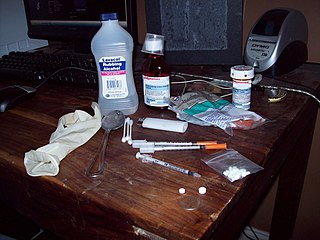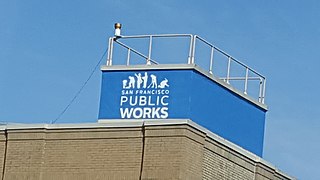
Harm reduction, or harm minimization, refers to a range of intentional practices and public health policies designed to lessen the negative social and/or physical consequences associated with various human behaviors, both legal and illegal. Harm reduction is used to decrease negative consequences of recreational drug use and sexual activity without requiring abstinence, recognizing that those unable or unwilling to stop can still make positive change to protect themselves and others.

A needle and syringe programme (NSP), also known as needle exchange program (NEP), is a social service that allows injecting drug users (IDUs) to obtain clean and unused hypodermic needles and associated paraphernalia at little or no cost. It is based on the philosophy of harm reduction that attempts to reduce the risk factors for blood-borne diseases such as HIV/AIDS and hepatitis.

A blood-borne disease is a disease that can be spread through contamination by blood and other body fluids. Blood can contain pathogens of various types, chief among which are microorganisms, like bacteria and parasites, and non-living infectious agents such as viruses. Three blood-borne pathogens in particular, all viruses, are cited as of primary concern to health workers by the CDC-NIOSH: HIV, hepatitis B (HVB), & hepatitis C (HVC).
Needle sharing is the practice of intravenous drug-users by which a needle or syringe is shared by multiple individuals to administer intravenous drugs such as heroin, steroids, and hormones. This is a primary vector for blood-borne diseases which can be transmitted through blood. People who inject drugs (PWID) are at an increased risk for Hepatitis C (HCV) and HIV due to needle sharing practices. From 1933 to 1943, malaria was spread between users in the New York City area by this method. Afterwards, the use of quinine as a cutting agent in drug mixes became more common. Harm reduction efforts including safe disposal of needles, supervised injection sites, and public education may help bring awareness on safer needle sharing practices.

James Duval Phelan was an American politician, civic leader, and banker. He served as nonpartisan Mayor of San Francisco from 1897 to 1902. As mayor he advocated municipally run utilities and tried to protect his constituents from the monopolistic practices of the trusts. He represented California in the United States Senate from 1915 to 1921 as a Democrat. Phelan was a progressive supporter of the policies of Woodrow Wilson and was a leader in the movement to restrict Japanese and Chinese immigration to the United States.

A needlestick injury is the penetration of the skin by a hypodermic needle or other sharp object that has been in contact with blood, tissue or other body fluids before the exposure. Even though the acute physiological effects of a needlestick injury are generally negligible, these injuries can lead to transmission of blood-borne diseases, placing those exposed at increased risk of infection from disease-causing pathogens, such as the hepatitis B virus (HBV), hepatitis C virus (HCV), and human immunodeficiency virus (HIV). Among healthcare workers and laboratory personnel worldwide, more than 25 blood-borne virus infections have been reported to have been caused by needlestick injuries. In addition to needlestick injuries, transmission of these viruses can also occur as a result of contamination of the mucous membranes, such as those of the eyes, with blood or body fluids, but needlestick injuries make up more than 80% of all percutaneous exposure incidents in the United States. Various other occupations are also at increased risk of needlestick injury, including law enforcement, laborers, tattoo artists, food preparers, and agricultural workers.

A needle remover is a device used to physically remove a needle from a syringe. In developing countries, there is still a need for improvements in needle safety in hospital settings as most of the needle removal processes are done manually and under severe risk of hazard from needles puncturing skin risking infection. These countries cannot afford needles with individual safety devices attached, so needle-removers must be used to remove the needle from the syringe. This lowers possible pathogen spread by preventing the reuse of the syringes, reducing incidents of accidental needle-sticks, and facilitating syringe disposal.

Sharps waste is a form of biomedical waste composed of used "sharps", which includes any device or object used to puncture or lacerate the skin. Sharps waste is classified as biohazardous waste and must be carefully handled. Common medical materials treated as sharps waste are hypodermic needles, disposable scalpels and blades, contaminated glass and certain plastics, and guidewires used in surgery.

Drug injection is a method of introducing a drug into the bloodstream via a hollow hypodermic needle, which is pierced through the skin into the body. Intravenous therapy, a form of drug injection, is universally practiced in modernized medical care. As of 2004, there were 13.2 million people worldwide who self-administered injection drugs outside of medical supervision, of which 22% are from developed countries.

The Priscilla Chan and MarkZuckerberg San Francisco General Hospital and Trauma Center (ZSFG) is a public hospital in San Francisco, California, under the purview of the city's Department of Public Health. It serves as the only Level I trauma center for the 1.5 million residents of San Francisco and northern San Mateo County. It is the largest acute inpatient and rehabilitation hospital for psychiatric patients in the city. Additionally, it is the only acute hospital in San Francisco that provides 24-hour psychiatric emergency services.

The government of the City and County of San Francisco utilizes the "strong mayor" form of mayoral/council government, composed of the Mayor, Board of Supervisors, several elected officers, and numerous other entities. It is the only consolidated city-county in California, and one of only thirteen charter counties of California. The fiscal year 2019–20 city and county budget was approximately $12.3 billion.
Crime scene cleanup is a term applied to cleanup of blood, bodily fluids, and other potentially infectious materials (OPIM). It is also referred to as biohazard remediation, and forensic cleanup, because crime scenes are only a portion of the situations in which biohazard cleaning is needed. Incidents which may require this type of cleanup include accidents, suicide, homicides, and decomposition after unattended death, as well as mass trauma, industrial accidents, infectious disease contamination, animal biohazard contamination or regulated waste transport, treatment, and disposal.

San Francisco Public Works (SFPW) is a governmental agency for the City and County of San Francisco in California. They are responsible for the care and maintenance of San Francisco’s streets and infrastructure. The department designs, builds, resurfaces and cleans streets; plants and maintains trees; designs, constructs and maintains city-owned facilities; designs combined sewers owned by San Francisco Public Utilities Commission; designs drainage facilities; conducts sidewalk and roadway inspections, constructs curb ramps, provides mechanical and manual street cleaning, removes graffiti from public property; and partners with the diverse neighborhoods in San Francisco. Public Works serves San Francisco residents, merchants and visitors 24 hours a day and seven days a week with a workforce of approximately 1,200 employees, as of 2009.
The St. James Infirmary, founded by members of the sex worker activist community in 1999, is a peer-based, full spectrum medical and social service organization serving current and former sex workers of all genders and their families. Located in the Tenderloin district in San Francisco, California, the St. James Infirmary is a 501(c)(3) public charity. Its services are free and confidential. Named after the sex worker rights activist and founder of COYOTE, Margo St. James, the St. James Infirmary is the first occupational safety and health clinic for sex workers run by sex workers in the United States.
Sankalp Rehabilitation Trust is a Mumbai-based NGO that works with the injecting drug using community since 1995, preventing HIV/AIDS through education and needle-exchange programme & disposals. Using a harm reduction approach, they provide services such as abscess management, basic medical care, counseling, and opioid substitution therapy to their clients. In 2008, Sankalp received the Red Ribbon Award from UNAIDS for their efforts.
Humanitarian Action is a non-governmental charitable organization based in St. Petersburg, Russia. Humanitarian Action carries out programs and outreach for HIV/AIDS prevention, and aiding street children, intravenous drug users, and sex workers. The program, founded in June 2001, grew out of the French NGO Doctors of the World, which created medical-social programs in Russia starting in 1995.
Low-threshold treatment programs are harm reduction-based health care centers targeted towards people who use substances. "Low-threshold" programs are programs that make minimal demands on the patient, offering services without attempting to control their intake of drugs, and providing counselling only if requested. Low-threshold programs may be contrasted with "high-threshold" programs, which require the user to accept a certain level of control and which demand that the patient accept counselling and cease all drug use as a precondition of support.
The San Francisco plague of 1900–1904 was an epidemic of bubonic plague centered on San Francisco's Chinatown. It was the first plague epidemic in the continental United States. The epidemic was recognized by medical authorities in March 1900, but its existence was denied for more than two years by California's Governor Henry Gage. His denial was based on business reasons, to protect the reputations of San Francisco and California and to prevent the loss of revenue due to quarantine. The failure to act quickly may have allowed the disease to establish itself among local animal populations. Federal authorities worked to prove that there was a major health problem, and they isolated the affected area; this undermined Gage's credibility, and he lost the governorship in the 1902 elections. The new governor, George Pardee, implemented public-health measures and the epidemic was stopped in 1904. There were 121 cases identified, resulting in 119 deaths.
New York City was affected by the AIDS epidemic of the 1980s more than any other U.S. city. The AIDS epidemic has been and continues to be highly localized due to a number of complex socio-cultural factors that affect the interaction of the populous communities that inhabit New York.
Harm reduction consists of a series of strategies aimed at reducing the negative impacts of drug use on users. It has been described as an alternative to the U.S.'s moral model and disease model of drug use and addiction. While the moral model treats drug use as a morally wrong action and the disease model treats it as a biological or genetic disease needing medical intervention, harm reduction takes a public health approach with a basis in pragmatism. Harm reduction provides an alternative to complete abstinence as a method for preventing and mitigating the negative consequences of drug use and addiction.











